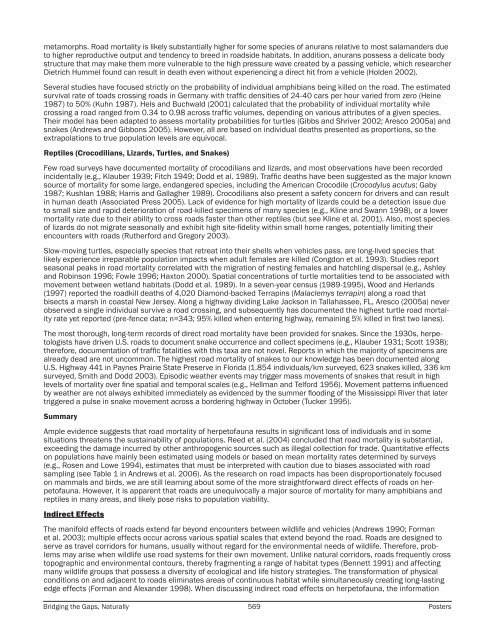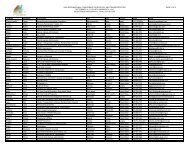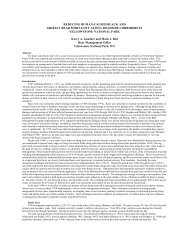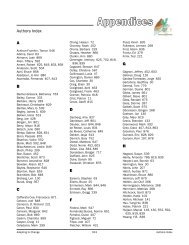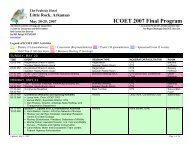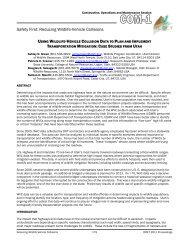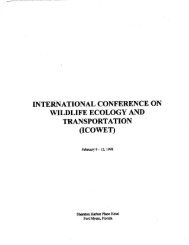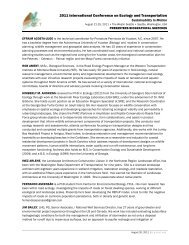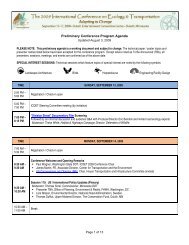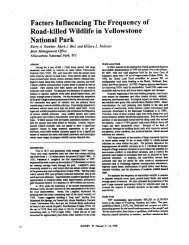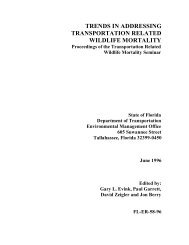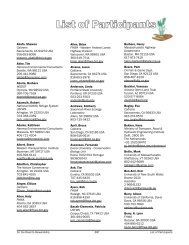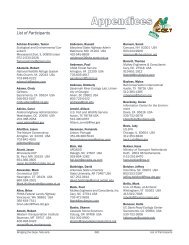Poster Sessions, pages 567-640 - ICOET
Poster Sessions, pages 567-640 - ICOET
Poster Sessions, pages 567-640 - ICOET
You also want an ePaper? Increase the reach of your titles
YUMPU automatically turns print PDFs into web optimized ePapers that Google loves.
metamorphs. Road mortality is likely substantially higher for some species of anurans relative to most salamanders due<br />
to higher reproductive output and tendency to breed in roadside habitats. In addition, anurans possess a delicate body<br />
structure that may make them more vulnerable to the high pressure wave created by a passing vehicle, which researcher<br />
Dietrich Hummel found can result in death even without experiencing a direct hit from a vehicle (Holden 2002).<br />
Several studies have focused strictly on the probability of individual amphibians being killed on the road. The estimated<br />
survival rate of toads crossing roads in Germany with traffic densities of 24-40 cars per hour varied from zero (Heine<br />
1987) to 50% (Kuhn 1987). Hels and Buchwald (2001) calculated that the probability of individual mortality while<br />
crossing a road ranged from 0.34 to 0.98 across traffic volumes, depending on various attributes of a given species.<br />
Their model has been adapted to assess mortality probabilities for turtles (Gibbs and Shriver 2002; Aresco 2005a) and<br />
snakes (Andrews and Gibbons 2005). However, all are based on individual deaths presented as proportions, so the<br />
extrapolations to true population levels are equivocal.<br />
Reptiles (Crocodilians, Lizards, Turtles, and Snakes)<br />
Few road surveys have documented mortality of crocodilians and lizards, and most observations have been recorded<br />
incidentally (e.g., Klauber 1939; Fitch 1949; Dodd et al. 1989). Traffic deaths have been suggested as the major known<br />
source of mortality for some large, endangered species, including the American Crocodile (Crocodylus acutus; Gaby<br />
1987; Kushlan 1988; Harris and Gallagher 1989). Crocodilians also present a safety concern for drivers and can result<br />
in human death (Associated Press 2005). Lack of evidence for high mortality of lizards could be a detection issue due<br />
to small size and rapid deterioration of road-killed specimens of many species (e.g., Kline and Swann 1998), or a lower<br />
mortality rate due to their ability to cross roads faster than other reptiles (but see Kline et al. 2001). Also, most species<br />
of lizards do not migrate seasonally and exhibit high site-fidelity within small home ranges, potentially limiting their<br />
encounters with roads (Rutherford and Gregory 2003).<br />
Slow-moving turtles, especially species that retreat into their shells when vehicles pass, are long-lived species that<br />
likely experience irreparable population impacts when adult females are killed (Congdon et al. 1993). Studies report<br />
seasonal peaks in road mortality correlated with the migration of nesting females and hatchling dispersal (e.g., Ashley<br />
and Robinson 1996; Fowle 1996; Haxton 2000). Spatial concentrations of turtle mortalities tend to be associated with<br />
movement between wetland habitats (Dodd et al. 1989). In a seven-year census (1989-1995), Wood and Herlands<br />
(1997) reported the roadkill deaths of 4,020 Diamond-backed Terrapins (Malaclemys terrapin) along a road that<br />
bisects a marsh in coastal New Jersey. Along a highway dividing Lake Jackson in Tallahassee, FL, Aresco (2005a) never<br />
observed a single individual survive a road crossing, and subsequently has documented the highest turtle road mortality<br />
rate yet reported (pre-fence data; n=343; 95% killed when entering highway, remaining 5% killed in first two lanes).<br />
The most thorough, long-term records of direct road mortality have been provided for snakes. Since the 1930s, herpetologists<br />
have driven U.S. roads to document snake occurrence and collect specimens (e.g., Klauber 1931; Scott 1938);<br />
therefore, documentation of traffic fatalities with this taxa are not novel. Reports in which the majority of specimens are<br />
already dead are not uncommon. The highest road mortality of snakes to our knowledge has been documented along<br />
U.S. Highway 441 in Paynes Prairie State Preserve in Florida (1.854 individuals/km surveyed, 623 snakes killed, 336 km<br />
surveyed, Smith and Dodd 2003). Episodic weather events may trigger mass movements of snakes that result in high<br />
levels of mortality over fine spatial and temporal scales (e.g., Hellman and Telford 1956). Movement patterns influenced<br />
by weather are not always exhibited immediately as evidenced by the summer flooding of the Mississippi River that later<br />
triggered a pulse in snake movement across a bordering highway in October (Tucker 1995).<br />
Summary<br />
Ample evidence suggests that road mortality of herpetofauna results in significant loss of individuals and in some<br />
situations threatens the sustainability of populations. Reed et al. (2004) concluded that road mortality is substantial,<br />
exceeding the damage incurred by other anthropogenic sources such as illegal collection for trade. Quantitative effects<br />
on populations have mainly been estimated using models or based on mean mortality rates determined by surveys<br />
(e.g., Rosen and Lowe 1994), estimates that must be interpreted with caution due to biases associated with road<br />
sampling (see Table 1 in Andrews et al. 2006). As the research on road impacts has been disproportionately focused<br />
on mammals and birds, we are still learning about some of the more straightforward direct effects of roads on herpetofauna.<br />
However, it is apparent that roads are unequivocally a major source of mortality for many amphibians and<br />
reptiles in many areas, and likely pose risks to population viability.<br />
Indirect Effects<br />
The manifold effects of roads extend far beyond encounters between wildlife and vehicles (Andrews 1990; Forman<br />
et al. 2003); multiple effects occur across various spatial scales that extend beyond the road. Roads are designed to<br />
serve as travel corridors for humans, usually without regard for the environmental needs of wildlife. Therefore, problems<br />
may arise when wildlife use road systems for their own movement. Unlike natural corridors, roads frequently cross<br />
topographic and environmental contours, thereby fragmenting a range of habitat types (Bennett 1991) and affecting<br />
many wildlife groups that possess a diversity of ecological and life history strategies. The transformation of physical<br />
conditions on and adjacent to roads eliminates areas of continuous habitat while simultaneously creating long-lasting<br />
edge effects (Forman and Alexander 1998). When discussing indirect road effects on herpetofauna, the information<br />
Bridging the Gaps, Naturally 569 <strong>Poster</strong>s


